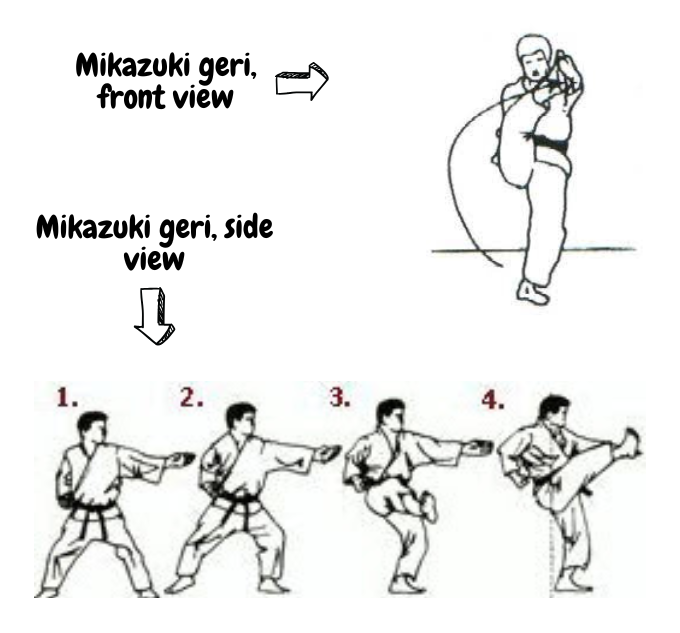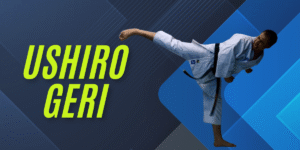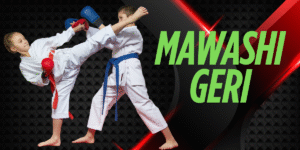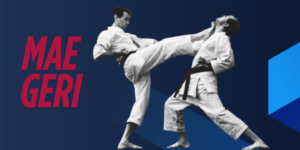Mikazuki Geri, or crescent kick in English, is one of the most used kicks in karate, especially in katas.
It’s that powerful, sweeping, that defy gravity.
Whether you’re a beginner trying to master it or an intermediate martial artist looking to sharpen your technique, understanding Mikazuki Geri and its variations, like Gyaku Mikazuki Geri and Soto Mikazuki Geri, can give you a significant edge in your training.
In this guide, I’ll walk you through what these kicks are and how to perform them correctly, and I’ll share some tips that will take your technique to the next level.
Keep reading if you’re ready to step up your martial arts game!
What is Mikazuki Geri?
Mikazuki Geri, or the “crescent kick,” is one of those moves that stands out in karate.
It’s often associated with Karate, Taekwondo, and Chinese martial arts.
The name Mikazuki means “crescent moon,” and that’s precisely the shape your leg makes as you perform the kick.
Unlike other kicks, such as Mae Geri or Yoko Geri, Your aim is not in front of you.
Instead, imagine your opponent is standing side by side with you. In that case, You can use Mikazuki Geri to attack him.
This kick uses your leg’s inside or outside arc to strike the opponent.
Mikazuki Geri can be used for offense or defense, depending on your stance, body rotation, and target.

The Different Types of Mikazuki Geri
While the Mikazuki Geri is known for its sweeping motion, not all crescent kicks are the same. This kick has different variations, each with its specific technique and use. Let’s break down the two main types:
- Gyaku Mikazuki Geri
2.Soto Mikazuki Geri.
Gyaku Mikazuki Geri (Reverse Crescent Kick)
Gyaku Mikazuki Geri is a reverse version of the regular crescent kick. This means instead of the arc coming from the outside of your body, you’ll be using the inside arc to strike your target.
The kick starts inwardly, crossing over your body before striking out in the opposite direction.
The motion is similar to the Mikazuki Geri. Still, it has a reverse angle, making it helpful in striking from unexpected angles.
This variation can be particularly effective when you want to catch your opponent off guard, as they will likely expect a standard crescent kick.
It’s commonly used to target the head, shoulders, or upper body. Still, with the right timing, it can also be used to block or deflect an incoming attack.
Soto Mikazuki Geri (Outside Crescent Kick)
On the other hand, Soto Mikazuki Geri uses an outward arc.
This version of the crescent kick is often easier to execute for beginners because the motion is more natural. However, it’s still highly effective when done with precision.
The Soto Mikazuki Geri usually starts with a quick chambering motion before your leg swings outward and strikes in a high arc, generally targeting the opponent’s head or shoulder.
What makes this kick so valuable is its ability to attack from a distance. It’s convenient for knocking opponents back or hitting them with the edge of your foot or shin.
Soto Mikazuki Geri can also be used defensively to intercept an incoming strike and create space between you and your opponent.
How to Perform Mikazuki Geri Correctly
Karate kicks are designed so that without a strong Kihon, You will struggle to perform even the simplest of kicks.
I assume you have a strong kihon and will put extra effort into improving your kicks.
Now let me share with you some tips that can help you with this kick:
Step 1: Start with the Right Stance
Before thinking about kicking, ensure you’re in the proper stance.
For Mikazuki Geri, you’ll want to start from a balanced fighting stance—whether in Karate, Taekwondo, or another style. A solid stance gives you stability, crucial for generating the power needed for the kick.
Key Point: Keep your knees slightly bent, your body relaxed, and your weight distributed evenly on both legs. Your hands should be up to protect your face or ready to strike.
Step 2: Chamber Your Leg
The next step is to chamber your leg. This is where you bring your kicking leg up and across your body, similar to preparing for a roundhouse kick.
The higher you chamber your leg, the more force you’ll be able to generate when you swing it out for the kick.
Key Point: For Soto Mikazuki Geri, chamber your leg towards the outside of your body. For Gyaku Mikazuki Geri, you’ll chamber your leg across your body, preparing for the reverse arc.
Step 3: Execute the Kick
Once your leg is chambered, it’s time to deliver the kick.
For Mikazuki Geri, you need to use a smooth, controlled motion to swing your leg in a high arc.
Make sure the motion is fluid, and remember, the kick’s power comes from your hips and core—not just your leg.
Key Point: For Soto Mikazuki Geri, the arc should start from the inside of your body and move outward, aiming to strike your opponent’s head or shoulders. For Gyaku Mikazuki Geri, the arc starts from the inside of your body and swings in the reverse direction, targeting similar areas.
Step 4: Follow Through and Recoil
After delivering the kick, be ready to quickly recoil your leg back to your stance. The kick shouldn’t just stop at contact—it’s vital to immediately return your leg to a defensive position to protect yourself and prepare for the next move.
Key Point: Avoid lingering after the kick. Quick recovery is just as important as the execution, so practice returning to your stance right after each kick.
How to Improve Your Mikazuki Geri
Mastering Mikazuki Geri doesn’t happen overnight, but there are a few key areas you can focus on to improve your technique and take it to the next level.
1. Focus on Strength and Flexibility
Like most martial arts techniques, Mikazuki Geri requires a balance of strength and flexibility. If your flexibility isn’t where it needs to be, your kicks might lack the height or fluidity you’re aiming for. On the other hand, if you’re not building enough leg strength, your kicks won’t pack the punch needed for real impact.
- Flexibility: Stretching regularly will help improve your hamstring and hip flexibility, allowing you to lift your leg higher and more fluidly during the kick. Include dynamic stretches and leg swings to get your body used to the motion.
- Strength: Exercises like lunges, squats, and leg lifts will help build the leg and core strength you need to kick with power. Strong legs are key to executing a controlled, effective Mikazuki Geri.
2. Improve Your Balance
Balance is everything when it comes to executing a solid Mikazuki Geri. If you’re off-balance, your kick won’t be as powerful, and you’ll have trouble recovering quickly. To improve your balance, try these exercises:
- Single-Leg Stance: Practice standing on one leg for 30-50 seconds. This will help strengthen your stabilizer muscles and improve your balance when performing the kick.
- Balance Board: Using a balance board or BOSU ball will force you to engage your core and legs more, helping you gain stability in your stance.
3. Work on Your Timing and Speed
One of the most critical aspects of Mikazuki Geri is timing. A well-timed kick can catch your opponent off guard, while a slow or predictable kick is easy to defend against. Practice with a partner or on a heavy bag to improve your timing. Work on kicking just as your opponent attacks or when the bag is swinging toward you.
- Speed Drills: Set up a timer and practice throwing Mikazuki Geri as fast as possible, focusing on how quickly you can recover and reset for the next kick. Speed is vital for striking and getting back into your stance.
- Reaction Drills: Practice reacting to a partner’s movements or a target that moves toward you. This helps develop reflexes and timing, ensuring your Mikazuki Geri is always sharp.
4. Practice with Targets or a Partner
Training alone is excellent, but to really improve, it’s helpful to practice with a partner or on a target. Using a kickpad or a focus mitt allows you to focus on accuracy, power, and timing. A partner can help you get feedback on your form, technique, and where your kick might need improvement.
- Target Focus: Have your partner hold a target at different heights (head, midsection, or leg) to practice hitting specific areas with Mikazuki Geri. This will improve your precision.
- Sparring: Light sparring with a partner allows you to practice your kicks in a more realistic setting, where you can work on speed, timing, and positioning.
5. Stay Consistent and Keep Practicing
Improvement in any martial arts technique takes time. Consistent practice is the key to making Mikazuki Geri feel second nature. Set aside time each week to focus specifically on this kick. Regular practice will lead to better results, whether you’re working on flexibility, strength, or just refining the motion.
Final Thoughts
Mastering Mikazuki Geri, whether it’s the classic version or its variations like Gyaku Mikazuki Geri and Soto Mikazuki Geri, can take your martial arts skills to the next level.
Mikazuki Geri is a hard kick to master, especially when delivering it with power and accuracy.
I have shared my knowledge with you. This can help you with your journey of enhancing your crescent kick skill.
FAQ
How can I tell if I’m performing Gyaku Mikazuki Geri correctly?
A key indicator that you’re performing Gyaku Mikazuki Geri correctly is ensuring that the arc of your kick comes from the inside of your body, swinging outwards across your body. Focus on turning your hips and torso to generate power from your core. The kick should feel smooth and controlled, without any jerky motions. If you’re hitting the target at the right angle and with good form, you’re on the right track!
Can Mikazuki Geri be used in self-defense?
Yes, Mikazuki Geri can definitely be used in self-defense situations. Its sweeping motion makes it an effective tool for defending against an opponent’s attack, especially when targeting the head or shoulders. The Gyaku Mikazuki Geri, in particular, is great for catching someone off guard with a reverse strike. If you’re looking to use this technique for self-defense, practice it in various scenarios so it becomes a natural reaction when needed.
How do I know when to use Soto Mikazuki Geri in a fight?
Soto Mikazuki Geri is great for creating distance or striking from a range. It’s often used when you want to keep your opponent at bay or land a decisive blow to their upper body, such as the head or shoulders. This kick is best used when you’re not in immediate close combat but want to deliver a quick, sweeping strike. It’s a great option when trying to control a fight’s pace.
You Might Also Like










